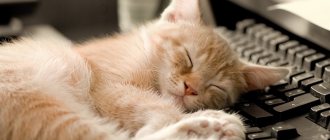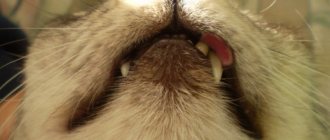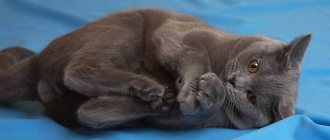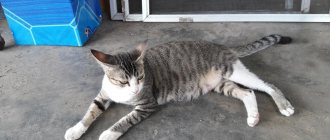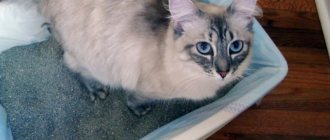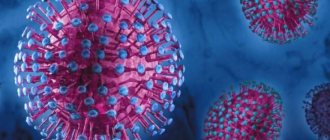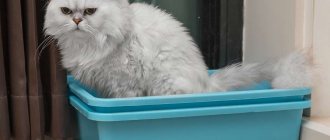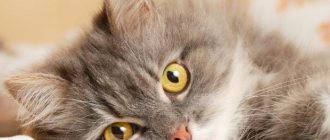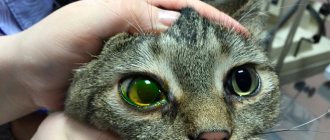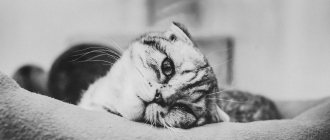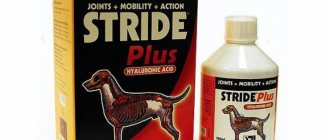Development of stomach ulcers: what are the causes?
The most common reason that causes the development of stomach ulcers in cats is pathologies of the main internal organs (liver, kidneys, etc.). All this, together with provoking factors (very hot food, violation of feeding regime) leads to peptic ulcer disease.
Other reasons:
- Incorrect feeding. The likelihood of developing peptic ulcers increases when feeding cats food from the table: sausage and frankfurters, spicy and smoked foods with spices. The pet's stomach is not accustomed to such food, so negative reactions are possible. Note! The most common provoking factor is feeding the animal with cheap dry and wet mass market food.
- Medicines. Diagnosis of gastritis and gastric ulcer in some cases is associated with the use of steroidal and non-steroidal drugs that have an anti-inflammatory effect. Use these medications with caution and only as prescribed by your veterinarian.
- Foreign objects When they enter the gastrointestinal tract, they deeply affect mucous and soft tissues. The result is the development of ulcerative processes. One of the common causes of the disease is the accumulation of hairballs in the stomach.
- Gastritis. Unfortunately, many owners neglect its treatment. However, it is associated with inflammation of the mucous membranes, and therefore, in the absence of proper therapy, can lead to ulcers.
- Poisoning. Household chemicals, spoiled food, expired food, acidic compounds and alkalis - all this can lead to severe intoxication and accelerated development of stomach ulcers in a cat.
Gastric ulcer in dogs
Gastric ulcer in dogs - Ulcus ventriculi canum - is an erosive inflammation of the gastric mucosa that occurs as a result of exposure of the damaged area of the mucosa to pepsin and hydrochloric acid. Gastric ulcers are most often reported in older service dogs.
The number of simple and peptic ulcers of the stomach in dogs is approximately equal and, as an exception, there are multiple ulcerative lesions of the stomach and duodenum.
Etiology . The appearance of stomach ulcers in dogs occurs when animals are fed for a long time with waste from cafes and canteens containing large amounts of salt, pepper, mustard and other substances that irritate the stomach. A violation of the feeding regime (long breaks, skipping regular feedings, etc.), feeding hot food, frozen meat, frozen fish to hungry animals predisposes to peptic ulcer disease. Any factors that cause hyperacid gastritis in a dog. Stomach ulcers are caused by stress on the dog (violation of training methods, change of owner, etc.). The medications used in treatment can provoke the appearance of ulcers in dogs - non-steroidal anti-inflammatory drugs (rumadil, ketofel), salicylates (aspirin), glucocorticoids (prednisolone, dexamethasone). Gastric ulcers in dogs can be caused by renal failure, neoplasms in the stomach, poisoning, bile reflux - which, due to the release of bile pigments, leads to excessive release of hydrochloric acid and pepsin in the stomach of dogs. A hereditary predisposition cannot be ruled out for the occurrence of peptic ulcer disease.
Pathogenesis . When the mucosal barrier is damaged as a result of the action of one or another etiological factor, when the mucus covering the mucous membrane cannot resist the action of hydrochloric acid and pepsin of the stomach, areas of the membrane not protected by mucus begin to be digested under the influence of hydrochloric acid and pepsin and ulcers form in their place.
Clinical picture . The course of gastric ulcer in dogs is usually chronic. Pet owners note that against the background of symptoms of chronic gastritis (deterioration or perversion of appetite, frequent belching), the dog’s general condition sharply worsens, weakness and depression appear, and emaciation begins to rapidly progress. A characteristic symptom of peptic ulcer disease appears - a few hours after feeding, she begins to vomit with blood or food masses that have the color of “coffee grounds”. Body temperature is within the physiological norm. On palpation in the stomach area (in the left hypochondrium), we get a painful reaction, sometimes leading to an attack of vomiting. Often, a sick dog, in order to reduce pain from an ulcer, is forced to take the pose of a “praying” animal. When auscultating the intestinal area, we note a weakening of peristalsis of the small and large intestines. A sick dog has frequent constipation and dark-colored stool. A sick dog refuses food, increased thirst appears, and the animal begins to lose weight. If a peptic ulcer in a dog continues for a long time, the general condition may improve, and then periods of exacerbation of the disease again appear, accompanied by a sharp deterioration in the general condition and frequent bouts of vomiting with blood. As a result of stomach bleeding, the dog develops anemia.
Pathoanatomical changes . When opening a dead animal, we find simple or peptic ulcers in the stomach. Simple ulcers come in various shapes and sizes, are accompanied by minor damage to the stomach tissue, and the edges of a simple ulcer are poorly defined. Some dogs may have blood in their stomach contents and scarring on the stomach wall. Peptic ulcers are usually localized on the lesser curvature of the stomach in the form of crater-shaped, round formations with clearly defined roll-like edges. When the ulcer perforates, we find a picture of septic peritonitis in the abdominal cavity.
The diagnosis of canine ulcer disease is made comprehensively based on the collected medical history, clinical symptoms of the disease, the results of gastroscopy, radiography with a contrast mass (the contrast agent is retained at the location of the ulcer - the so-called “niche”, a sharp slowdown in the evacuation of the contrast mass from the stomach in 12-12 minutes). the duodenum). Additionally, we perform an ultrasound examination of the abdominal organs - we get a picture of thickening of the stomach wall. A hematological blood test reveals a decrease in hemoglobin levels and the number of red blood cells, an increased ESR, leukopenia, a decrease in the amount of total protein, with a relatively increased content of gamma globulins. A positive reaction during an exacerbation of the disease to the presence of blood pigments in the feces.
Differential diagnosis . When conducting a differential diagnosis, a veterinarian excludes diseases such as pancreatitis, hepatitis, cholecystitis, renal failure (nephrosis, nephrosclerosis), foreign body in the gastrointestinal tract, poisoning, infectious diseases of dogs (leptospirosis, parvovirus enteritis, etc.), parasitic diseases (pyroplasmosis (babisiosis), dirofilariasis, etc.).
Treatment . If a dog is admitted to a veterinary clinic with symptoms of a perforated ulcer, urgent surgical intervention is performed (excision of the ulcer with plastic surgery of the stomach wall). During a recession, the causes of the disease are eliminated. Dietary feeding consisting of liquid or semi-liquid food with a sufficient amount of vitamins is prescribed: milk soups and cereals with the addition of butter or vegetable oil, egg whites, milk. It is good to use special industrially produced food for animals suffering from gastrointestinal disorders - Hills Rescription Diet i/d.
In order to reduce the production of hydrochloric acid and pepsin by the dog's stomach, H2 receptor blockers are used - cimetidine, ranitidine, famotidine. Proton pump inhibitors – omeprozole, pariet, pexidin, losec. Medicines that protect the gastric mucosa - sucralfate, Venter, Almagel. M-cholinergic blockers, causing a decrease in the secretion of all digestive glands: atropine, gastrocenin, buscopan (in tablets or suppositories). Antiemetic drugs – sereniya, cerucal, motilium. Hemostatic agents – dicynon, vikasol. To reduce the acidity of gastric contents, normalize secretion and reduce bleeding, sick dogs are prescribed burnt magnesia (0.5-1.0), magnesium oxide (0.5-1.0), aluminum bicarbonate, calcium carbonate, gastrofarm, gasterin. No-shpa is used as a pain reliever. In order to accelerate the regeneration process of damaged gastric mucosa and as an anti-inflammatory agent, pentoxyl and solcoseryl are used. Antibacterial drugs - metronidazole, modern cephalosporin antibiotics.
Prevention . Dogs prone to gastrointestinal diseases must be fed dietary food. Do not allow dogs to swallow foreign objects (nails, badges, buttons, wire, sharp chips, stones, etc.) during walks. Apply all possible measures to prevent stress in animals. When using nonsteroidal anti-inflammatory drugs and glucocorticoids, it is necessary to use H2 blockers simultaneously. Dog owners should promptly treat gastritis, pancreatitis and stomach tumors in dogs. Conducts timely treatment of diseases that are accompanied by vomiting and bile reflux in dogs.
Main symptoms of the disease
It is problematic to independently distinguish gastritis from gastric ulcer. The symptoms of these pathologies largely coincide, so to make an accurate diagnosis, we recommend contacting a veterinary clinic.
Among the symptoms indicating the development of a stomach ulcer:
- severe pain,
- vomiting with blood,
- rapid weight loss,
- oppression,
- lethargic state
- constipation,
- pallor of the mucous membranes,
- black chair,
- elevated temperature,
- specific odor from the mouth.
Note! When palpating the abdominal area, cats experience pain: they worry, moan, and meow loudly.
Owners will immediately notice changes in the pet’s behavior: it becomes very lethargic and apathetic, practically does not move, and stops playing and running. He lies down, rests and sleeps more. Refuses to eat and drinks a lot.
Symptoms of illness in a pet
In the initial stages, peptic ulcer disease in dogs is most often asymptomatic, and only with the development of severe damage to the organ can the owner observe the following symptoms:
- The animal loses its appetite. The thirst persists. Sharp weight loss occurs.
- The pet's condition is lethargic and apathetic. Weakness and depression are constant companions of a sick dog.
- A perversion of taste is often observed. The dog eats inedible objects.
- The dog may take a forced “praying” position, indicating pain in the epigastric region. The dog stretches its front legs forward, while its chest lies on the floor, the pelvic part of the body is raised up.
- When palpating the abdomen in the stomach area, the dog experiences discomfort and anxiety due to pain.
- Constant belching after eating.
- Vomit. The owner, as a rule, observes it in the animal several hours after feeding. The dog experiences discomfort and pain. During vomiting, the animal strongly contracts its abdominal muscles. After the stomach is emptied of food masses, the animal does not experience relief from its condition. Vomit is usually dark in color and mixed with blood.
- If gastric bleeding develops, so-called “coffee grounds” are observed - the vomit becomes dark coffee, sometimes black, in color, which is caused by digested blood. The symptom characterizes severe damage to the gastric mucosa and requires immediate professional intervention.
- Against the background of vomiting, the dog shows signs of dehydration and electrolyte imbalance: dry skin, dull, disheveled hair, sunken eyeball.
- Violation of the mechanical and enzymatic functions of the stomach leads to constipation, alternating with diarrhea. Feces are characterized by the presence of undigested food particles and a foul, sour odor.
- In advanced cases, the sick animal exhibits signs of anemia in the form of pallor of the visible mucous membranes.
The development of the disease occurs over a long period of time without any external manifestations. Vomiting blood is a symptom of severe damage to the stomach tissue and requires urgent veterinary attention.
How does the disease progress? Forms and their characteristics
Peptic ulcer disease occurs in cats of various breeds and ages. It is not inherited and is not contagious. The disease occurs in pets in different forms:
- Simple (acute). Characterized by sudden attacks and accompanied by severe pain, which intensifies when pressing on the abdominal area.
- Progressive (chronic). Usually asymptomatic, so the owner in the initial stages does not notice any changes in the animal’s appetite, appearance and behavior.
Both forms of peptic ulcer require professional treatment.
Diagnosis of stomach ulcers
If your animal's gastrointestinal tract is disrupted, contact your veterinarian immediately. He will conduct a visual examination, take a medical history and prescribe a number of studies.
Basic diagnostic methods:
- Clinical blood test. Based on its results, the presence of anemia and the degree of its development (in case of internal bleeding) are assessed;
- Biochemical blood test. It is necessary to study the condition of the main internal organs, including the liver and kidneys;
- X-ray examination with the introduction of contrast. It excludes (confirms) the presence of foreign objects in the stomach.
- Gastroscopy. Helps determine the position of ulcers and the form in which the disease occurs.
Only a specialist can make an accurate diagnosis and develop an effective treatment plan for your pet's stomach ulcers.
Caring for an animal with a stomach ulcer
An animal with a stomach ulcer should be examined regularly by its veterinarian. Since this disease occurs with relapses, medications may be recommended that the cat or dog will receive for quite a long time or at certain intervals. It is important to follow the recommendations of a veterinarian and not cancel or skip medications.
The diet recommended for the pet must also be strictly followed. Feeding any other foods is not allowed, it is prohibited to pick up food on the street, or receive treats “from the table”. Strict adherence to the diet is another chance to prolong the period of remission of the disease.
Limiting stress and strenuous exercise is also important for animals with stomach ulcers. High-quality home care, combined with qualified and timely veterinary care, helps a cat or dog with stomach ulcers live long enough and increases the period of remission.
Treatment of peptic ulcer
Treatment for gastric ulcers in cats is symptomatic: water and electrolyte balance is restored, drugs with analgesic and antiemetic effects are prescribed, and a dietary regimen is prescribed.
If there are signs of dehydration, infusion therapy is performed. A dropper is installed, the basis of which is a 0.9% solution of sodium chloride with glucose or other components (as prescribed by the treating veterinarian).
If the development of a stomach ulcer is provoked by pathogenic microorganisms Helicobacter Pylori, antibacterial therapy is carried out, and drugs are prescribed to increase blood clotting. In severe cases, when the bleeding cannot be stopped, a gastrotomy is performed.
The next stage of treatment is the restoration of the cat’s body. In order to strengthen internal organs and systems, vitamins are prescribed:
- A (retinol),
- E (tocopherol),
- C (ascorbic acid),
- B6 (pyridoxine).
The key to successful treatment is the elimination of the factor that provoked the development of gastric ulcer. Upon completion of therapy, we recommend regularly visiting the veterinarian to eliminate the possibility of relapses.
Treatment
Depending on the degree of ulcerative damage to the organ, both conservative treatment methods and surgical care are used in veterinary practice.
Drug therapy
In case of chronic course and minor damage to the mucous membrane during the period of remission, drug treatment methods are used to treat the dog.
First of all, a sick dog is prescribed H2 receptor blockers. The action of the drugs is aimed at reducing the production of hydrochloric acid and pepsin by stomach cells. In veterinary practice, histamine inhibitors such as Cimetidine, Nizatidine, Roxatidine, Famotidine are successfully used.
Proton pump inhibitors help reduce the negative effects of aggressive acid and digestive enzymes on stomach tissue. Omeprazole has found wide use in veterinary medicine. Dogs can also be prescribed Pariet and Pexidin. To protect the mucous membrane, the veterinarian often uses Almagel and Sucralfate.
In case of severe vomiting, a sick animal is prescribed antiemetic drugs, for example Cerucal. Motilium helps reduce nausea and vomiting. If blood is detected in the vomit, the dog is prescribed hemostatic agents - Vikasol, Dicynon, vitamin K. In severe cases, infusion therapy is performed to eliminate dehydration.
In case of pain, the dog is prescribed painkillers, for example, No-shpu, Spazgan.
In order to regenerate damaged tissues, immunostimulating drugs such as Solcoseryl and Pentoxyl are used in the treatment of peptic ulcers.
Drug therapy for gastric ulcers in dogs is not complete without the use of antibacterial agents. The presence of Helicobacter pylori, as well as the very fact of erosive damage to the mucous membrane, requires the use of modern cephalosporin antibiotics.
Good results in the treatment of gastric ulcers in animals are achieved by using Metronidazole.
Therapeutic diet
Without dietary adjustments, drug therapy for the treatment of gastric ulcers, as a rule, does not bring tangible results.
In this regard, the veterinarian often prescribes, along with medications, a caudate patient, first a starvation diet, and then a therapeutic diet.
On the first day after the hunger strike, the sick dog is given a slimy porridge in water (rice or oatmeal) without oil. Gradually, protein foods in the form of chicken broth are included in the diet. Meat can be given 7-10 days after an exacerbation. Preference is given to chicken and lean beef. Fatty varieties are contraindicated for animals with ulcers.
It is useful to diversify your diet with boiled vegetables and lactic acid products. An excellent source of protein are chicken eggs and cottage cheese.
A sick dog should be fed in small, fractional portions 4 to 5 times a day. This diet will reduce the acidity of gastric juice and normalize the motor-evacuation function of the organ. Food should be at room temperature. Hot and cold food is contraindicated for a sick dog.
If your pet is used to eating ready-made dry food, your veterinarian will recommend special medicinal mixtures, for example, Hill's i/d or Royal Canin Gastro Intestinal. The high degree of digestibility of the proteins contained in the feed, the presence of prebiotics and organic acids have a positive effect on the regeneration processes of the damaged mucous membrane of the digestive tract.
Dry food should be pre-soaked in a small amount of water and ensure that clean filtered water is freely available to the sick pet.
Food for diseases of the gastrointestinal tract in dogs
Surgical methods
The asymptomatic course of the initial stage of the disease often leads to the fact that at the time of development of clinical signs we are talking about a serious pathology in the form of perforation of an ulcer, gastric bleeding. In this case, the veterinarian decides to surgically remove the area of the stomach affected by the ulcer, followed by suturing the tissue.
The operation is performed under general anesthesia and requires careful care of the sick dog during the rehabilitation period.
Features of the diet for ulcers
Therapy for peptic ulcer disease in a cat is associated with changes in its diet and nutrition. It is recommended to feed your pet 4-5 times a day, but in small portions. Make sure that food is at room temperature: too hot or cold foods can cause an exacerbation of the disease.
Recommended food:
- liquid rice porridge,
- other slimy porridges (for example, oatmeal),
- weak meat broths (chicken, turkey),
- dairy and fermented milk products (for example, kefir, low-fat cottage cheese, cream),
- boiled eggs,
- boiled vegetables (carrots, broccoli).
It is forbidden to give cheap dry food, canned food, or food from the table. If you still have questions related to your cat's nutrition, be sure to consult your veterinarian!
Diagnostics
Preliminary diagnosis of peptic ulcer disease in dogs and cats
can be diagnosed based on detection of signs of gastrointestinal bleeding (eg, hematemesis, melena, iron deficiency anemia) in animals without coagulopathy. During the collection of anamnesis and examination, the cause (stress, use of NSAIDs, AMF) can be identified. Perforation may cause peritonitis, acute abdominal syndrome, and sepsis. Due to the fact that AMLs can resemble almost any other skin lesion, all masses and nodular skin lesions should be examined cytologically. Liver failure is usually diagnosed based on serum biochemical analysis. Contrast radiography is informative for the diagnosis of foreign objects and, sometimes, peptic ulcers. Ultrasound can sometimes reveal thickening of the stomach wall (as with an infiltrative lesion) and/or defects in the gastric mucosa. The most sensitive and specific method for diagnosing peptic ulcers is endoscopy, and in combination with biopsy can be used to diagnose tumors, foreign bodies and inflammation that may cause ulcers. Detection of duodenal erosions may indicate the presence of gastrinoma. If gastrinoma is suspected or there are no other probable causes of the disease, serum gastrin concentration is measured.
How to prevent the development of the disease?
A balanced diet will help prevent the development of gastric ulcers. Proper nutrition is the basis for your pet's good health. Do not feed him from the table, do not give him “human” foods, your cat should have its own menu.
A few more rules that will help avoid stomach ulcers in your animal:
- Never give your pet even small bones: they can lead to obstruction of the digestive canal or damage to the mucous membranes;
- If you give your cat dry or canned food, don’t skimp! Cheap products can lead to gastrointestinal disorders, including stomach ulcers;
- Diversify your diet. Consider your cat's diet so that it receives all the necessary vitamins and nutrients.
Stomach ulcer is a dangerous disease. It requires quick diagnosis and effective treatment. When the first signs of gastrointestinal diseases appear, do not hesitate: seek professional help from a veterinary gastroenterologist!
Etiology
Ulcers and erosions of the stomach and intestines are more common in dogs than in cats.
There are several potential reasons. Stress ulceration is accompanied by severe hypovolemic, septic or neurogenic shock, as after trauma, surgery or endotoxemia. Ulcers in dogs and cats are usually located in the body, fundus or antrum of the stomach and/or duodenum. Excessive strain (eg, in sled dogs) can cause ulceration/erosion of the body and fundus of the stomach, likely as a result of a combination of poor perfusion and high concentrations of circulating glucocorticoids.
NSAIDs (eg, aspirin, ibuprofen, naproxen, piroxicam, flunixin) are a leading cause of gastric and intestinal erosions/ulcers in dogs as they have a longer half-life in dogs than in humans. Naproxen, ibuprofen, indomethacin and flunixin are definitely dangerous for dogs. Concomitant use of more than one NSAID or use of an NSAID in combination with corticosteroids (especially dexamethasone) increases the risk of developing ulcers. Newer COX-2-selective NSAIDs are less likely to cause ulcers; however, ulcers can develop in dogs and cats if these drugs are used inappropriately (high doses, lack of adequate drug washout between different NSAIDs, concomitant use of corticosteroids). The use of NSAIDs in animals with poor visceral perfusion (animals with heart failure, in shock) may also increase the risk of developing peptic ulcers. Most steroids pose minimal risk unless the animal is already at increased risk of developing peptic ulcers (eg, hypoxia of the gastric mucosa due to shock or anemia). However, dexamethasone is definitely an ulcerogenic drug when used in large doses.
Breast tumors can release histamine (especially if radiation or chemotherapy is given), which stimulates the secretion of gastric juice.
Gastrinomas are apudoms that develop primarily in the pancreas. They are usually found in older dogs and, rarely, in cats. These tumors secrete gastrin, which leads to severe gastric hyperacidity, duodenal ulceration, esophagitis and diarrhea.
Peptic ulcer disease rarely develops in renal failure, while liver failure is one of the significant causes of the development of the disease in dogs.
Foreign objects rarely cause erosion/ulceration, but they do interfere with healing and increase blood loss through the ulcer. In some dogs, IBD may be accompanied by peptic ulcers. Gastric neoplasia and other infiltrative diseases (pythiosis) can also cause peptic ulcers. Tumors are especially significant as a cause of peptic ulcer disease in older dogs and cats.
